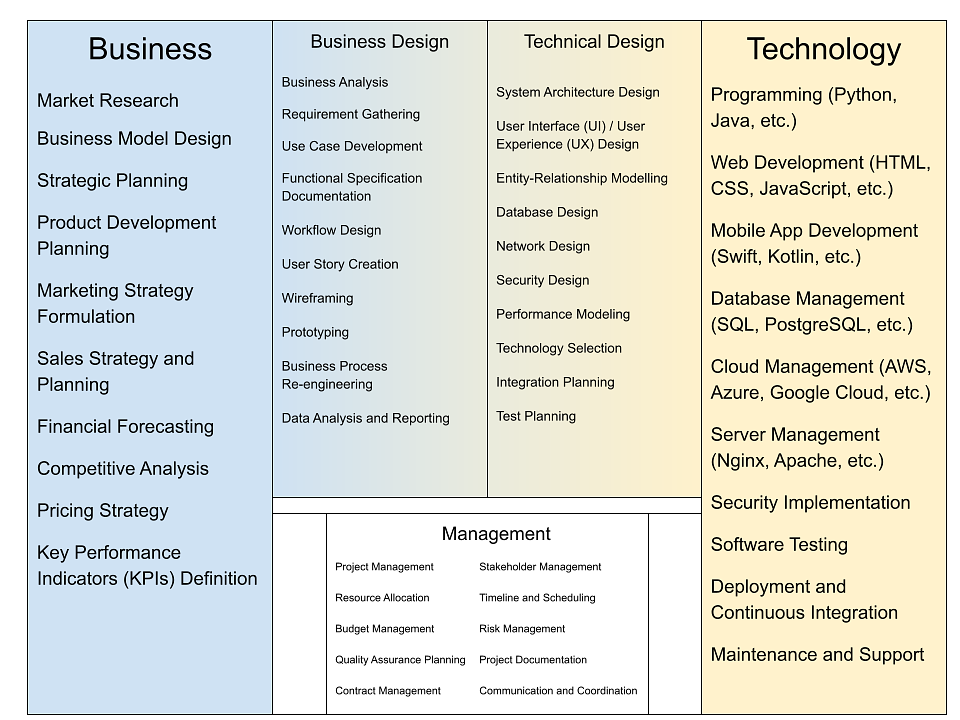It's not always easy to understand the subtle nuances that exist between the business end and the technology end of projects. Where does one end and the other begin? How do they intertwine and interact? And most importantly, how can we navigate this spectrum to deliver the most effective solutions to our clients?
Welcome to the concept of the Business-Technology Gradient. This is a way to visualize and understand the multifaceted nature of web development projects. We break down the whole process into four categories: Business, Management, Design, and Technology. By understanding these categories and how they interact, we can better plan, manage, and execute our projects, creating solutions that are not only technically sound but also closely aligned with business goals. Let's dive in.
.png)
-
Business
This category forms one end of the spectrum and represents high-level, strategic planning and decision-making activities. This is the stage where broad business objectives are determined, and overarching market strategies are developed. Key activities include defining the product-market fit, establishing unique selling propositions (USPs), and setting out marketing strategies. Sales planning and the analysis of return on investment (ROI) also fall under this umbrella. It's all about understanding the market, identifying opportunities, and positioning the business to leverage these opportunities. For example, in a software development context, this might involve identifying a market need for a particular kind of software solution, determining how your solution will be unique or better than existing options (the USP), and laying out strategies for reaching and convincing potential customers.
-
Management
As the bridge between business and technology, this category involves coordinating and managing how the business's strategic goals are translated into technological solutions. This includes client and project management, where you'd coordinate with clients to understand their needs and manage the resources, timelines, and activities needed to deliver a solution. It also includes risk management, where you'd identify potential challenges or roadblocks in a project and plan how to avoid or mitigate them. This is about ensuring that business strategies are effectively carried out through technology.
-
Design
This category is split into two distinct but related subcategories:
-
Business Design
This involves the initial stages of designing a tech solution based on business needs. Key tasks include business analysis, where you'd examine the business's operations and identify how a tech solution could improve them; requirements gathering, where you'd define what the solution needs to do to provide value; and creating functional specifications, where you'd outline the specific features and functions the solution will have. This is about translating the high-level business strategy into a detailed plan for a technology solution.
-
Technical Design
This is where the tech solution starts to take shape. You'd be making key decisions about the software architecture, or how the solution will be structured and organized; designing the user interface to ensure a good user experience; and conducting entity-relationship modeling, or outlining how different elements of the solution will interact with each other. This stage sets the groundwork for the actual coding and building of the tech solution.
-
Business Design
-
Technology
This is the other end of the spectrum, where the actual creation, implementation, and maintenance of the tech solution happen. This involves web development and programming, using specific tools and languages (like Ruby, JavaScript, SQL, etc.) to build the software. It also includes working with databases and servers (like PostgreSQL, Nginx, etc.), as well as DevOps activities to streamline the development process and ensure the solution is reliable and efficient. This is all about turning the design and plans from the earlier stages into a working, effective technology solution.
Activities and the Business-Technology Gradient
Here are examples of the types of activities that fall within each category of the business-technology gradient:
-
Business:
- Market Research
- Business Model Design
- Strategic Planning
- Product Development Planning
- Marketing Strategy Formulation
- Sales Strategy and Planning
- Financial Forecasting
- Competitive Analysis
- Pricing Strategy
- Key Performance Indicators (KPIs) Definition
-
Management:
- Project Management
- Stakeholder Management
- Resource Allocation
- Timeline and Schedule Management
- Budget Management
- Risk Assessment and Management
- Contract Negotiation and Management
- Communication and Coordination
- Quality Assurance Planning
- Project Documentation
-
Design:
- Business Design:
- Business Analysis
- Requirement Gathering
- Use Case Development
- Functional Specification Documentation
- Workflow Design
- User Story Creation
- Wireframing
- Prototyping
- Business Process Re-engineering
- Data Analysis and Reporting
- Technical Design:
- System Architecture Design
- User Interface (UI) / User Experience (UX) Design
- Entity-Relationship Modelling
- Database Design
- Network Design
- Security Design
- Performance Modeling
- Technology Selection
- Integration Planning
- Test Planning
- Business Design:
-
Technology:
- Programming (Python, Java, etc.)
- Web Development (HTML, CSS, JavaScript, etc.)
- Mobile App Development (Swift, Kotlin, etc.)
- Database Management (SQL, PostgreSQL, etc.)
- Cloud Management (AWS, Azure, Google Cloud, etc.)
- Server Management (Nginx, Apache, etc.)
- Security Implementation
- Software Testing
- Deployment and Continuous Integration
- Maintenance and Support
This list is a guide; specific tasks can differ based on unique project needs and business requirements.
In a nutshell, these categories cover the full range from strategic planning to detailed technical implementation, with each category building on the previous ones to deliver a cohesive, effective tech solution.